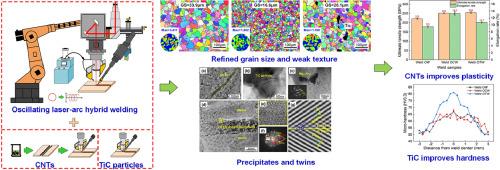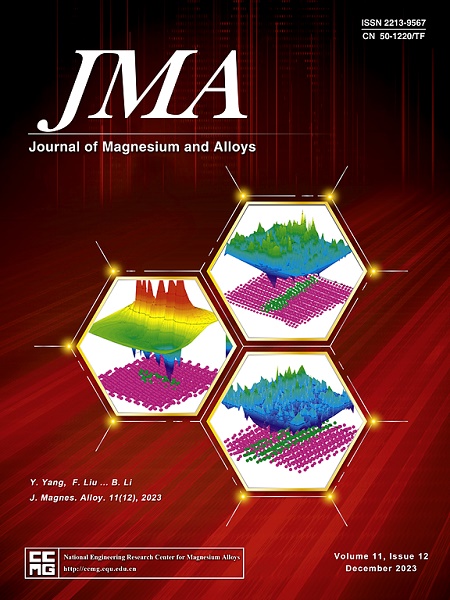添加 CNT 和 TiC 粒子后镁焊缝的晶粒细化、孪晶形成和力学性能
IF 13.8
1区 材料科学
Q1 METALLURGY & METALLURGICAL ENGINEERING
引用次数: 0
摘要
本文研究了添加碳纳米管(CNT)和 TiC 粒子的镁焊缝的微观结构和机械性能。结果表明,焊缝的微观结构主要表现为等轴晶粒,晶界几乎呈高角度。添加 CNTs 和 TiC 粒子后,平均晶粒尺寸分别细化了 51% 和 23%。添加 CNTs 后,位错密度和 CSL 边界比例增加,而添加 TiC 粒子后,位错密度和 CSL 边界比例降低。此外,由于位错堆积导致的应力集中,焊缝内部形成了不常见的{101¯1¯3}收缩孪晶,从而形成了Σ29 CSL边界。添加 CNTs 后,极限拉伸强度和伸长率分别提高了 13.5 % 和 40 %;添加 TiC 颗粒后,极限拉伸强度和显微硬度分别提高了 14.8 % 和 20.9 %。本文章由计算机程序翻译,如有差异,请以英文原文为准。


Grain refinement, twin formation and mechanical properties of magnesium welds with addition of CNTs and TiC particles
In this work, microstructure and mechanical properties of Mg weld with addition of carbon nanotubes (CNTs) and TiC particles were investigated. The results showed that the weld microstructure was mainly presented as equiaxed grains with almost high angle grain boundaries. The introduction of reinforcements promoted the formation of precipitates and refined the grains effectively, the average grain size was refined by 51% and 23% with addition of CNTs and TiC particles, respectively. The dislocation density and the fraction of CSL boundaries were increased with addition of CNTs, while those were decreased with addition of TiC particles. Besides, the infrequent {103} contraction twins formed within the weld due to the stress concentration caused by dislocation accumulation, which contributed to the Σ29 CSL boundary. The ultimate tensile strength and elongation rate were increased by 13.5% and 40% with addition of CNTs, while the ultimate tensile strength and micro-hardness were increased by 14.8% and 20.9% with addition of TiC particles.
求助全文
通过发布文献求助,成功后即可免费获取论文全文。
去求助
来源期刊

Journal of Magnesium and Alloys
Engineering-Mechanics of Materials
CiteScore
20.20
自引率
14.80%
发文量
52
审稿时长
59 days
期刊介绍:
The Journal of Magnesium and Alloys serves as a global platform for both theoretical and experimental studies in magnesium science and engineering. It welcomes submissions investigating various scientific and engineering factors impacting the metallurgy, processing, microstructure, properties, and applications of magnesium and alloys. The journal covers all aspects of magnesium and alloy research, including raw materials, alloy casting, extrusion and deformation, corrosion and surface treatment, joining and machining, simulation and modeling, microstructure evolution and mechanical properties, new alloy development, magnesium-based composites, bio-materials and energy materials, applications, and recycling.
 求助内容:
求助内容: 应助结果提醒方式:
应助结果提醒方式:


